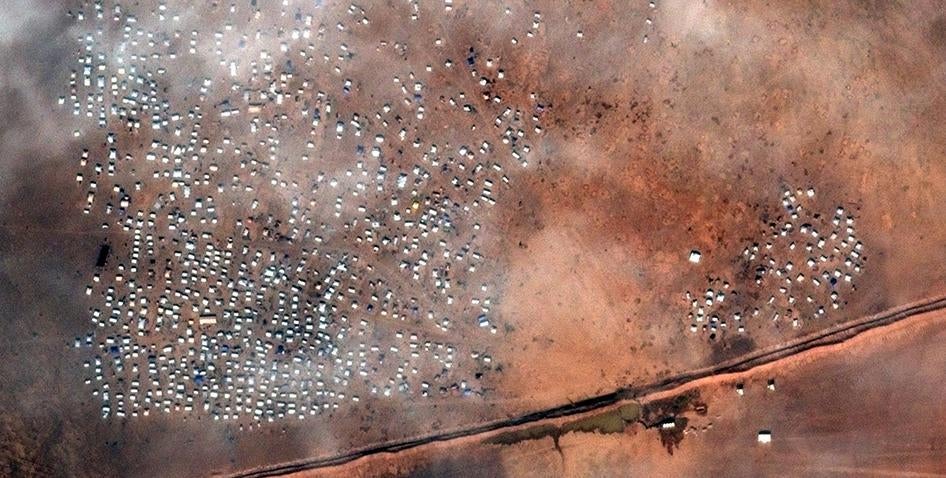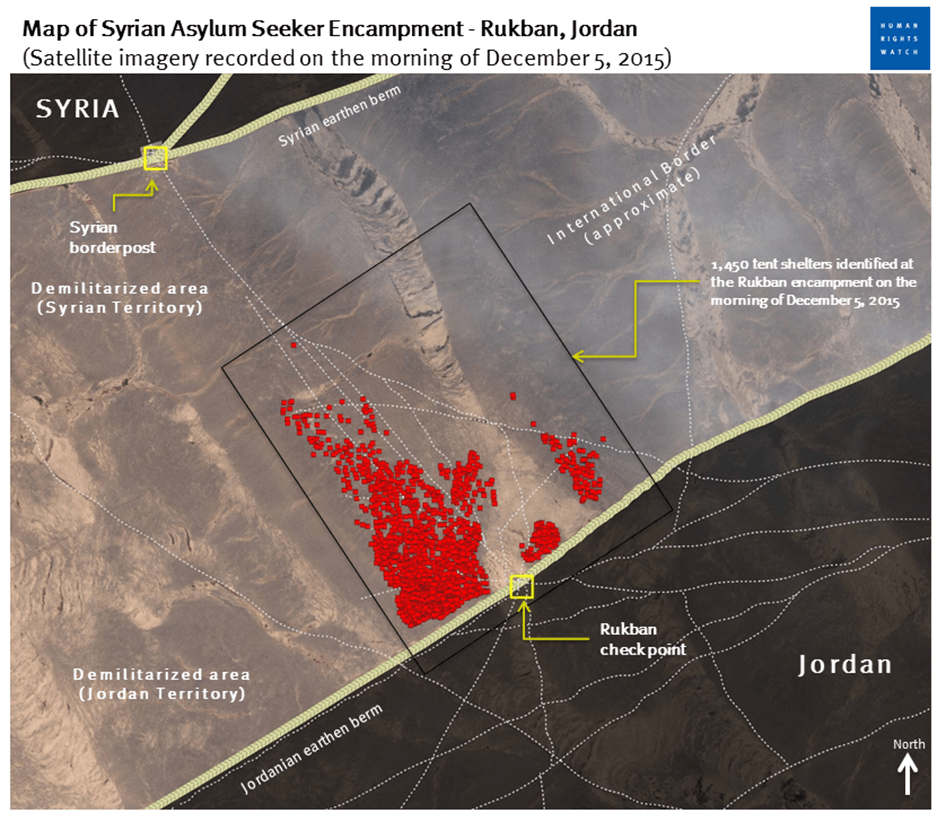(Beirut) – Jordan is blocking thousands of Syrian asylum seekers at its northeastern border region in deplorable conditions, Human Rights Watch said today. Satellite images taken on December 5, 2015, confirm that thousands of people are stuck in remote desert areas just inside Jordan’s border with Syria.
Aid workers with close knowledge of the situation say the vast majority of the 12,000 people in the area are women and children who urgently need more food, water, and medical assistance. On December 8, the United Nations refugee agency (UNHCR) said they included the sick and wounded, and that Jordan was putting people’s lives at risk. Jordan should stop stranding people in remote border areas for months on end and swiftly screen them in the country’s well-established transit centers, Human Rights Watch said.
“Jordan is blocking 12,000 people fleeing war in remote desert areas without proper help,” said Nadim Houry, deputy Middle East and North Africa director at Human Rights Watch. “The authorities should swiftly allow them to reach transit centers and should make sure they get all the help they need.”
In June, Human Rights Watch documented that Jordan’s mid-2013 border closure near Syria’s most populated areas in the west had forced Syrians to travel hundreds of kilometers to the far northeastern part of Jordan, where some were allowed to cross at the Rukban and Hadalat border points, north of the Jordanian town of al-Ruweishid.
However, in July 2014, Jordan also severely restricted entry at these two border crossings. Since then, thousands of Syrians have waited for two to three months to reach Jordan’s asylum seeker transit sites, living in tents just north of a raised sand barrier, or “berm,” which marks the limit of a demilitarized zone inside Jordan, several hundred meters south of the Syrian-Jordanian border.
In early 2015, the authorities allowed people reaching the border to swiftly move onto the transit sites further inside Jordan. But since then, aid workers say, Syrians have again remained stuck there for months and border guards have only allowed a few dozen a day to reach the transit sites. They say there is no system to identify the most vulnerable.
Aid workers say that in mid-November, the number of people arriving in the berm area significantly increased, and that on November 26, the authorities blocked all entry. On December 7, small groups were allowed to move to transit sites.
A satellite image of the northern side of the berm at Rukban, taken the morning of December 5, revealed more than 1,450 tent structures, indicating the likely presence of thousands of Syrians. Satellite imagery taken in April showed only 175 such structures in the area.
Aid agency staff say the increasing numbers stuck at the berm are making hygiene and sanitation worse, and that children are suffering from diarrhea, vomiting, and acute malnutrition. They fear that plunging winter temperatures will trigger additional serious health problems and possibly death, especially among children and the elderly.
Aid workers say that they don’t have sufficient aid and other resources to assist the growing numbers of people at the border, and that unless Jordan allows them to move to transit sites, 20,000 people will be stuck in the border area by the end of the year.
Five Syrians from the southern town of Daraa, just five kilometers from the Jordanian border, told Human Rights Watch in Turkey in late October that they had not even tried to flee to Jordan because the Jordanian border was closed and that Jordanian border guards would have shot them had they tried to cross with smugglers. Instead, they travelled the full length of Syria to cross to Turkey.
As of December 2, the UN refugee agency had registered 632,000 Syrians in Jordan. Human Rights Watch has repeatedly called for other countries to increase their assistance to Jordan and to resettle greater numbers of Syrian refugees living in Jordan.
“Jordan’s schools, hospitals, and cities remain under tremendous pressure, given the sheer numbers of Syrians in the county,” Houry said. “International donors should be doing their utmost to make sure Jordan protects Syrians at the border and doesn’t push them back.”











